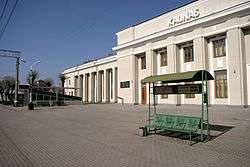Kaunas railway station
Kaunas railway station (Lithuanian: Kauno geležinkelio stotis) is a Lithuanian Railways central passenger railway station in Kaunas. It is located at the eastern edge of Central Kaunas, Lithuania. Kaunas railway station was included into the Registry of Immovable Cultural Heritage Sites of the Republic of Lithuania in 2003.[1]

History
After the Russian Empire lost the Crimean War, the importance of use of tactical use of modern inventions, as well as railways. In February 1851 the Government of Russia made a decision to build the Saint Petersburg–Warsaw Railway line. Starting from 1858 the line connecting Saint Petersburg and Warsaw was being built. In the territory of Lithuania, the construction of the railway section Daugavpils–Vilnius–Grodno including the branch Lentvaris–Kaunas–Kybartai (Virbalis) was started in spring 1859. The first railway stations in Lithuania were constructed on this line (21 stations): the super class stations in Lentvaris and Virbalis, as well as the first class stations in Kaunas and Vilnius. Due to the hilly and unfavorable for the direct rail passage terrain around Kaunas' centre, the Kaunas Railway Tunnel and largest in Lithuania railway bridge over the Nemunas river were constructed. On the 15 August 1861 the first train left Kaunas and reached Lentvaris.[2] Kaunas railway station was officially opened on 21 February 1862. In 1944, the station was bombed by the withdrawing German army.[3] The present-day Kaunas railway station was built in 1948 on the foundation of the old station and designed by architect Petr Ashastin. Its architecture was based on the principles of classicism: strict symmetry, separate and large-scale inner spaces, horizontally continued shape, massive walls and centrally oriented stairs.[4] The station was reconstructed between 2005 and 9 April 2008.[3]
.png)
International Passenger Trains
Direct weekend trains to Białystok (Poland) are operated by Polish railway company Przewozy Regionalne.[5] These run on the non-electrified single track 1435 mm rails added as a first stage of the Rail Baltica project. As of 2019, this line terminates in a dedicated double-sided platform on the south-east side of the station.
References
- The Registry of Immovable Cultural Heritage Sites: Unique object code: 28268. Retrieved on 15 December 2010.
- Archived 2011-07-22 at the Wayback Machine Lithuanian Railways. The History of the Tunnel. Retrieved on 15 December 2010.
- Kaunas: Dates and Facts. Under the Rule of Tsarist Russia. Retrieved on 15 December 2010.
- City and Ideology: Soviet Kaunas of 1945-1965 by Vaidas Petrulis. Retrieved on 15 December 2010.
- "Archived copy". Archived from the original on 2016-09-20. Retrieved 2016-09-05.CS1 maint: archived copy as title (link)
| Wikimedia Commons has media related to Kaunas train station. |